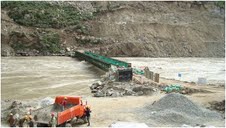China Starts construction of the first of the five dams on Brahmaputra River
Chinese plan for diversion of water resources, originating from Tibetan plateau, has become a highly contentious International issue between China on one hand and many downstream countries like India, Bangladesh, Myanmar, Thailand, Laos, Cambodia and Vietnam. China is planning to build or is in the process of building dams, on all major rivers originating from Tibet. This is naturally creating much resentment and heartburn in the riparian downstream countries. The economies of these countries and the lives of their people are principally dependent on the waters flowing in these rivers. Yet, China continues to pay only lip service to this issue by issuing denials and arranging international seminars.China has yet not signed any river water treaty with any of the downstream country.
In spite of these denials, details started leaking out in the Chinese press about construction of first such dam on Brahmaputra. With high quality satellite imagery now available to Internet users, it is impossible even for a secretive Chinese government to hide such a project from internet users. When latest images of the first dam construction were published on the internet, Chinese government had to accept this fact. The first dam on the Brahmaputra river is coming up at Zangmu (Tibetan name Dzam) having 92.522996 and 29.141999 as longitude and latitude. One of China’s biggest engineering and construction companies, China Gezhouba (Group) Corp, has been awarded a contract worth 1.14 billion yuan ($167 million) for a hydropower plant here. Gezhouba’s subsidiary, No 5 Engineering Co Ltd, will provide concrete and aggregate processing services for the Zangmu Hydropower project, the company says on its website. The company will be responsible for designing, constructing and running the project that supplies 3.4-million cu m of concrete and 8-million-ton aggregate for the water power station. The project is expected to last until the end of December 2015. Tibet Power Generation Co Ltd of China Huaneng Group, the country’s top power generator, would proved finance for the Zangmu Water Power Station. Zangmu Power station will start producing power in 2013. The electricity goes to Lhasa as a high voltage power line is planned for connecting the Lhasa power grid.

The dam is 389.5 m long and 76 m wide at the bottom and 19 m at the top. The flow rate of the river further down streams will be maintained. During normal operations the reservoir will have 86.6 million cubic meters of water.

This is the amount of water flowing on average about every 24 hours down the river. Installed power generating capacity is 510 MW and expected power generating capacity is 2.5 billion kw/h per year. The three villages of Zangmu, Tangmai and Dagu (Chinese names) would be submerged in the water reservoir. The local population would be resettled in part of Giacha and Sangri counties.



The second dam on Brahmaputra is now in planning stage. And would come up at 12 KM downstream from Zangmu dam. The location of the power station is 5 kilometers to the west or upstream of Giacha county seat. The installed power generating capacity is 320 MW and the dam will maintain a water level of 3244 m above sea level. The reservoir will be filled with 28.87 million cubic meters of water. The expected power generating capacity is 1.527 billion kw/h per year.
Concerns of downstream countries on Brahmaputra, i.e. India and Bangladesh seem to have been addressed at present as both of these would be run of the river projects. This means that river water would not be diverted at least at present. However when all the five dams would be completed eventually, one can not say for sure that water from reservoirs would never be diverted. Such an eventuality would turn out to be a major problem for India but would be a calamity or a disaster for Bangladesh.
During 1950, China’s People’s Liberation Army set out to ‘liberate’ the roof of the world. The government of India, having inherited past treaties signed by the British with Tibet, were not only shocked at China’s unprovoked military action in Tibet, but were also offended by how the Chinese government had disregarded its explicit assurances to India that Tibet would be left alone. The British and US governments had strongly supported the Indian position on Tibet and had offered all possible help to Tibet and India.
Most surprisingly, then Prime minister of India, Jawaharlal Nehru, suddenly decided then to wash his hands off Tibet and even dissuaded US government from giving military help to Tibet. He offered Tibet to China, on a platter, without any preconditions and failed to extract a price like settling border disputes between India and China and a concrete river water sharing agreements.
This is turning out to be the biggest and the blunder of the century, committed by the Government of Independent India and the repercussions of the same not only would haunt India but also other countries like Bangladesh and Myanmar for many many decades to come.
30 August 2010
You may also be interested in reading my earlier Blog on same subject.
Strongest takes all
No comments:
Post a Comment